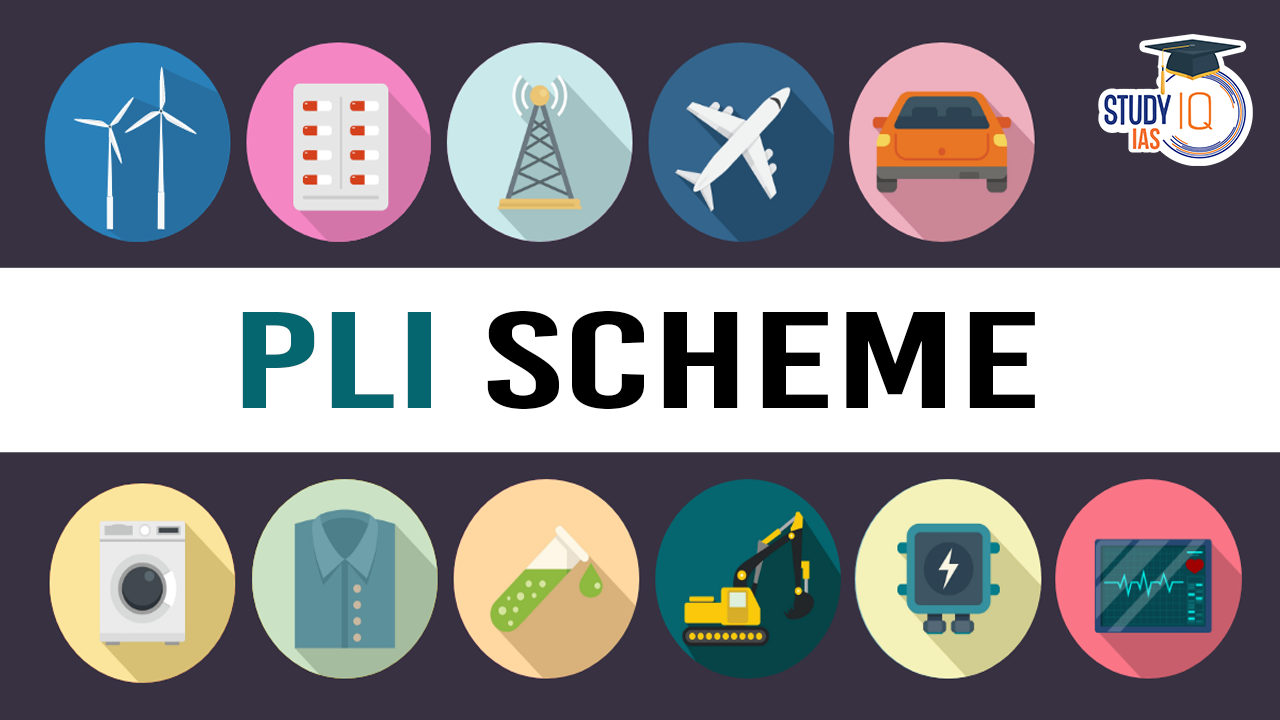Table of Contents
Context: The Smartphone Production-Linked Incentive (PLI) scheme, the most successful among the 14 such schemes, may be extended by a couple of years beyond its official end date of 2025-26.
Smartphone PLI Scheme Generates Revenue 19 Times The Incentives Disbursed
Production Linked Incentive (PLI) Scheme
The Product Linked Incentive (PLI) is a government initiative to boost domestic manufacturing in specific sectors by offering financial rewards to companies based on their incremental sales.
| About PLI Scheme | |
| Launched | March 2020 |
| Objective | The PLI scheme targets enhancing India’s manufacturing capabilities and reducing dependence on imports.
|
Sectors Covered Under PLI Scheme
Initially, the scheme focused on three industries –
- Mobile manufacturing and electric components,
- Pharmaceuticals, and
- Medical device manufacturing.
It expanded in November 2020 to include ten more sectors: Electronic/Technology Products, Pharmaceuticals, Telecom & Networking Products, Food Products, White Goods (ACs & LED), High-Efficiency Solar PV Modules, Automobiles & Auto Components, Advance Chemistry Cell (ACC) Battery, Textile Products, and Specialty Steel. Later, in September 2021, Drones and Drone Components were also added.
Incentive Structure
The PLI scheme offers financial incentives to boost domestic manufacturing of advanced technology products and attract investments in the automotive manufacturing value chain. The incentives are applicable for sales of products manufactured in India over a period of five consecutive years, starting from April 1, 2022.
Sector-Wise Implementation
Different ministries are responsible for implementing the PLI scheme in their respective sectors. For example, the Ministry of Electronics and Information Technology manages the electronics and IT hardware sector, which includes mobile phones, specified electronic components, laptops, tablets, etc.
Impact on Food Processing and Other Sectors
In the food processing sector, the PLI scheme supports the manufacture of specific food product segments and helps in branding and marketing Indian food products internationally.
- Similarly, in the medical devices sector, the scheme targets a range of devices, including cancer care, radiology, imaging, and implants.
- The scheme is also significant in the speciality steel sector, focusing on five categories of speciality steel products.
| Related Information |
|
Data Related To PLI Scheme
- Employment: Employment generation (direct & indirect) of over 6.78 lakh individuals.
- Exports: Exports have surpassed Rs. 3.20 lakh crore.
- Sector Contributions: Significant sectors include Large-Scale Electronics Manufacturing, Pharmaceuticals, Food Processing, and Telecom & Networking products.
- MSME Beneficiaries: 176 MSMEs are among the beneficiaries in various sectors.
- Incentive Disbursement: Around Rs. 4,415 crore was disbursed as incentives for 8 sectors.
- Local Manufacturing: Local manufacturing of various electronic components.
- PLI beneficiaries have about 20% market share but contributed to approximately 82% of mobile phone exports in FY 2022-23.
- Mobile Phone Production and Exports: Smartphones are now the fourth-largest export item from India with 42 per cent.
- Increase in Domestic Production:
- Domestic production of smartphones increased to Rs 4.1 trillion in FY24.
- This is up from Rs 2.14 trillion in FY20, the year before the scheme was announced.
- Rise in Exports:
- Smartphone exports from India rose to Rs 1.2 trillion in FY24.
- This is a significant increase from Rs 27,225 crore in FY20.
- Increase in Domestic Production:
- Foreign Direct Investment (FDI): FDI increased by ~254% since the inception of the PLI scheme for Large-Scale Electronics Manufacturing (LSEM).
- Pharmaceuticals: Significant reduction in raw material imports. Manufacturing of unique intermediate materials and bulk drugs like Penicillin-G in India.
- Medical Devices Production: Production of 39 medical devices has commenced.
- Telecom Sector: 60% import substitution achieved. Sales increased by 370% in FY 2023-24 compared to the base year FY 2019-20.
- Drone Industry: Significant impact on investment with a CAGR of 90.74%.
- Food Processing: Increase in sourcing of raw materials from India.
- Sales of organic products increased.
- Indian brand visibility in the international market has been enhanced.
- Increased millet procurement from 668 MT (FY 20-21) to 3,703 MT (FY 22-23).
- Atma Nirbhar Vision: PLI Schemes for 14 key sectors with an incentive outlay of Rs. 1.97 lakh crore (over US$26 billion) are under implementation.


 Operation Shiva 2025: Indian Army’s Ma...
Operation Shiva 2025: Indian Army’s Ma...
 e-Zero FIR Initiative, Key Features, Use...
e-Zero FIR Initiative, Key Features, Use...
 World Youth Skills Day 2025, Theme, Hist...
World Youth Skills Day 2025, Theme, Hist...





















